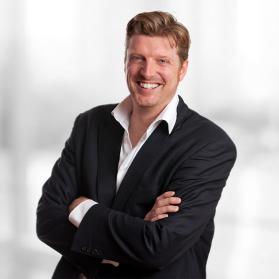Deutsche Telekom's Board of Management department Technology and Innovation underwent a transformation in 2018 - the aim was to create a skill-based, agile pool of experts. Today, innovation projects are staffed flexibly and transparently from this so-called Innovation Hub (iHub). A big step towards the future, but also a venture within a complex corporate environment. In this interview, program managers Mark Nierwetberg and Daniel Teckentrup talk about a road full of stumbling blocks, the great challenge of convincing the workforce and social partners of the new model, but also about the new transparency and speed.
Detecon: What were the general conditions that prompted you to transform the innovation division in 2018?
Mark Nierwetberg (MN): The division had an extremely complex hierarchical structure, completely “boxed” and “crated.” This naturally meant unnecessarily long decision-making channels, superfluous reporting, and pressure to justify one’s actions. Moreover, the division had accepted a lot of queries from the segments for project support and was in this sense only an “extended workbench,” not an innovation driver. When all was said and done, everyone was really busy, but the actual innovation strategy was not being pursued. There was a lack of focused orientation on goals.
Daniel Teckentrup (DT): In addition, the original innovation division was made up not only of innovation, but included parts of delivery as well – i.e., normal operations for current products – and the organization was structured just the way you would expect for a delivery: hierarchical and set up to last a long time. Transparency was also in short supply, whether with respect to the availability or lack of skills or to projects. In an innovation division, opportunities and risks go hand in hand; projects can be successful, but they can also be a dead end. Our organizational structure and culture of mistakes at the time was not aligned with this. It was clear that we would require a flexible organization for the innovation division. To be clear, we are not saying that a flexible organization is the right solution for everything; on the contrary, in many areas such as delivery or the so-called governance functions, we expressly do not want to have that. But we want to have the appropriate organizational structure for every type of work, and that was not the case here.
So what exactly were the objectives for the program?
DT: The objective was to perform a genuine “reset” in the innovation division. The intent was to create an agile environment in which people worked flexibly and transparently on strategically relevant innovation topics. That means learning from failures as well and reacting to them quickly and without a lot of red tape.
MN: We wanted to get away from the never-ending “fine tuning” of the organization and move to a chapter logic in which I could also set up a project within one week if needed. The focus was on thinning out the tangled skein of teams and boxes and on creating transparency in the workforce. We now see for the first time, for example, how many programmers are at full capacity, what they are working on, and how they are calibrated among one another in their capabilities.
Changes in a corporate environment are not easily realized, especially when changes are being made in the structural organization – which is what you did. What approach did you take?
DT: The economic pressure in the innovation division was very high. Pressure from the social partner was also high because the way work was done there put the burdens on the backs of the employees. Meaning: the employees belonged to a box for a product. If this product was discontinued, there was a threat to the employees that their box might also become “superfluous” – simply because the organizational structure did not permit more flexible responses. Efforts to prevent such social hardships naturally meant that there were a lot of project zombies, dead horses that people continued to ride because the existence of the project also secured the existence of the workers’ own box. We were prepared to make mutual concessions in our interaction with the social partner – across all levels. The pressure at the cost of the employees was too great, and that had a negative impact on performance.
So you used the sense of urgency. How can we imagine the road from the old hierarchical to the new flexible organization?
MN: Actually, we said we want to make a clean classification of the workforce we have and look into the various “Tupperware boxes,” i.e., the teams. They all contained the same paints, e.g., project managers, programmers, designers, and so forth. We then set up appropriate pillars and started an offer procedure in which a sufficient number of positions for programmers, designers, and so on were tendered in every pillar. The employees were asked to move from their teams into the pillars and to form separate chapters. The important point was the will to secure certain target figures. We wanted to have more programmers and AI experts, more doers than corporate functionaries or project managers. We set up pillars of different dimensions for this purpose.
DT: We agreed on some important principles with the social partner quite quickly and used them as a foundation. It was clear that we would need good solutions for redundancy scenarios. There were already various agreements on this matter. There was also agreement that innovation and delivery would be regarded separately. Moreover, things were to be simplified. And this was not to turn into a dismantling program; the guiding principle was one of “request and promote.” And we agreed to present the situations to all local works councils and to bundle the actual negotiations at the highest social partner level. That was important and helpful because the introduction of a flexible organization was also a journey into the unknown and involved roles that had never before been found anywhere at all in the corporation.
From the Tupperware box to the pillar: doesn’t that sound more like a return to the silo?
DT: Yes, but in a different way. In fact, we created as few chapters as possible, and that’s good. There could be the temptation to make even finer differentiations and to create additional pillars for even more roles. As a concept, that sounds at first like a fine idea, but doesn’t have any advantages in reality – the opposite, in fact. We noticed that we need as few profiles – but that can be specifically limited – as possible and as many as absolutely necessary. For instance, the chapters Design, Hardware, Software and project managers can be clearly distinguished from another. It was quite a battle for Telekom and an imposition for employees as well to do this in an offer procedure. It involved more than simply transferring people to the described positions; we had to obtain clarity and assurance that the people actually had the skills that were explicitly demanded. But this was necessary because the task of these chapters is the professional advanced development of the employees on the basis of their skills.
How did the concept of management change as a consequence of a chapter instead of a department logic?
DT: There are two kinds of managers in the new world: the chapter heads, who by and large take care of their employees and do not become involved in projects. No one is forced to move into management; people must want, and be able, to assume such a position. We definitely had high-ranking experts – from the software field, for instance – who explicitly did not want to have a management position. And then there are the project managers, who need other skills: they must be able, even without disciplinary authority, to weld people into a team, they must have knowledge of the market and know how many workers with what skills they require for a project. So these are (in prototype form) the two types of managers that we need. Since the target organization was supposed to be made up of far fewer boxes stacked within one another, the consequence was that the number of managers also declined sharply, namely, by almost 40%. Now, with iHub, there are 6 chapters with team leads plus resource management as managers, and that’s it. We approached the topic of managers with determination and clearly defined and filled these roles in strict observance of the logic behind them. We wanted to influence the organizational culture. And that can be achieved only with determination and resolve.
These new managers will still run into managers of the old school in the organization who are outfitted with all the insignia of power. What do you offer to the new managers, including future prospects, so that they are satisfied with their situation?
MN: In the meantime, I have gained the impression that the issue of team size was not at all so decisive for the managers; this was more a means to an end, to achieving a certain impact. We must now prove that they can trust the system and that they will continue to have this impact, even without direct access to employees. We used to have a situation in which managers were highly reluctant to turn people over to others because they were afraid they would no longer have access to these workers. And that was for me a completely valid argument in the old structure. I can understand that it is really difficult at this point to trust these cooperative structures. Moreover, team size is always a “negotiation argument” for salary and expression of importance, and so the old system has to be turned off in this sense. This aspect is remedied by the so-called expert career that is currently being implemented in the corporation so that experts can also be moved to the executive level. But we have barely started out on our journey. Assessing managers according to impact and not to the size of budgets and teams is not yet the norm.
DT: One thing that has helped, of course, is that the new managers retained or even improved their previous classification and status and that they were assuming a pioneer role on this road to a “new world.” And in the future we should encourage precisely this world, this new type of managers, with greater energy.
What are the first fruits that the change has brought? And how measurable are they?
MN: Because of the transparency that we now have, there has been a highly valuable discussion on the topic of outsourcing of knowledge and whether we will finance the learning curve of some service providers, particular in the IT area. This was previously not possible because all we had (at best) was a gut feeling. Now we have hard facts. And precisely discussions of this type help us now to regain a healthy manager-to-doer/programmer relationship. I regard that to be enormously important for us as an innovation division so that we have clarity about our capabilities.
So from a culture of administration and coordination of external forces to a sexy doer culture?
MN: I don’t know if sexy is the right word, but it is in any case a more dynamic culture that is quick to create pilots, to test, and to reject; an administration and contract awarding culture is becoming more and more a software engineering and doer culture. In the past, we observed that the share of projects for which a result was scheduled in five years was becoming greater and greater. You could assume that the real goal was to push delivery farther and farther back so that no one would ultimately be measured by success or failure. Nor did anyone dare to say that the product would definitely never be functional because there was always the accompanying fear that the section would then be closed. Speaking provocatively, we can say that we only simulated innovation.
DT: Right. The innovation simulation unit has become an innovation unit. To put it humorously: if in the old world the entire management board had said we needed 20 experts for a certain, new innovation project immediately, we would not have been able to find this group of people right away because of the structure and previous practices. Now we are in a position of being able to start and staff new projects at any time. This is a great leap forward. Of course, we will see failures. But it is good that we will see them now.
Now that a year has passed, are there any signs that binding commitment is leading to results and is not seen only in the project planning?
MN: Movement can be seen, for instance, in the projects Smart Speaker (even though it is taking longer than we thought), in our drone projects, for the topics blockchain, Mobile Edge X, and others. We are able to assess more quickly whether we will be able to do something alone or not. We used to bask in the illusion that we are Deutsche Telekom, and so of course we can do everything. And that is simply not true. We need partners in many cases.
DT: We used to try for as many “moonshots” as possible, but they were often merely cover for product management, and naturally they didn’t have any failures to report. But now we have only a few moonshots, and some of them will really fly.
Interviewed by Marc Wagner and Christian Hinrichsen.






